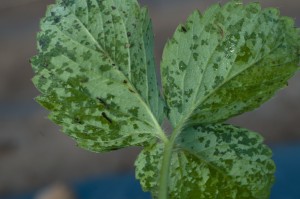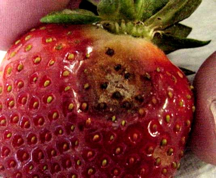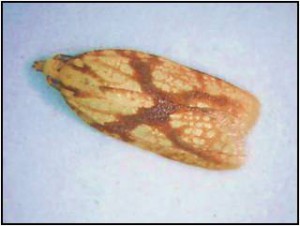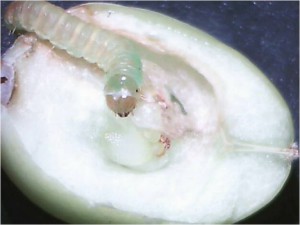Degree-day benchmarks indicate discrete biological events in the development of insect pests. For the Sparganothis fruitworm, recent studies conducted by Dr. Shawn Steffan (USDA-ARS/University of Wisconsin-Madison), Annie Deutsch (University of Wisconsin-Madison), and Cesar Rodriguez-Saona (Rutgers University) have isolated the key development events and linked them to degree-day (DD) accumulations. These degree-day accumulations can improve treatment timings for cranberry IPM programs in spring and summer.
Archives for May 2015
Cranberry IPM: Sparganothis Fruitworm Degree-Day Benchmarks Provide Key Treatment Timings
Angular Leaf Spot in Strawberries
Often considered a minor pathogen, angular leaf spot caused by the bacterium, Xanthomonas fragariae, can cause serious leaf and calyx infections ruining the marketability of fruit if left uncontrolled. Like all bacterium, the pathogen will infect leaves and the calyx through natural openings or wounds.

Fig. 1. Water-soaked lesions caused by angular leaf spot on infect strawberry leaf. Photo by P. Nitzsche
[Read more…]
Strawberry Fruit Rots 2015

Anthracnose Fruit Rot of Strawberry
Pathogens such as anthracnose, gray mold (Botrytis), and leather rot can become systemic problems in strawberry plantings once established. All three fungal diseases are soil-borne and once in fields can be difficult to manage over the lifetime of the planting.
The use of mulch (matted rows) to prevent/reduce soil splashing and keeping fruit from coming into direct contact with the soil surface can be beneficial in organic production systems where conventional fungicides cannot be used. Use of long crop rotations and staying away from areas of the farm with known instances of any of these pathogens is also important. Remember that same species of Colletotrichum that causes fruit rot in pepper and other crops can also infect strawberry.
Vegetable Disease Briefs – 5/3/15
Basil downy mildew has been found in potted greenhouse-grown basil. All growers producing basil should scout on a regular basis. Basil downy mildew is seed-borne and can cause significant losses.
Late blight has been found in FL and CA. To track the movement of Late blight in the US please visit USAblight.
Cucurbit downy mildew has been found on yellow summer squash, acorn, cucumber, and giant pumpkin in FL and on watermelon in TX. To track to progress of cucurbit downy mildew in the US please visit the downy mildew forecasting website at NCSU.
Vegetable Disease Update – 5/3/15
Cabbage
Damping-off – To help control losses due to damping-off pathogens apply Ridomil Gold (mefenoxam, FRAC code 4) at 1 to 2 pt/A, MetaStar (metalaxyl, 4) see label, or azoxystrobin at 0.40 to 0.80 fl oz 2.08SC/1000 row ft (for Rhizoctonia only), or Ridomil Gold at 1.0 to 2.0 pt/A 4SL plus azoxystrobin at 0.40 to 0.80 fl oz 2.08SC/1000 row ft. in a band up to 7 in. after seeding. To help control damping-off pathogens in Collards and Kale only: Apply Uniform (mefenoxam + azoxystrobin, 4 + 11) at 0.34 fl oz 3.66SE/1000 ft row. For more information please see 2015 New Jersey Commercial Vegetable Production Recommendations Guide. [Read more…]
North Jersey Fruit Meeting I: May 7, 2015
Date: Thursday, May 7, 2015
Time: 6:00 p.m. – 8:45 p.m.
Location: Rutgers Snyder Farm, 140 Locust Grove Road, Pittstown, NJ 08867
Agenda
6:00 p.m. Orchard Tour – Leaves promptly at 6:00 p.m.
- Observe NC-140 – Apple Rootstock Trials
- Observe 5 high density apple Tall Spindle Apple Plantings and Trellis Systems Planted 2002, 2008, 2010, 2011, 2014, Spacing varies from 2×10, 3×14 and 3×12
- Asian Pear Variety Trial – 5th leaf
- Update on the Rutgers NJAES Project to release new strawberry varieties for the eastern US
Peter Nitzsche, Win Cowgill, Bill Hulbik – Rutgers Cooperative Extension (RCE)
6:50 p.m. (back indoors)
- Stone and Pome Fruit: Bacterial Disease Management
Dr. Norm Lalancette, Specialist in Tree Fruit Pomology, RCE - Utilizing thresholds in IPM for fruit pests
Anne Nielsen, Specialist in Tree Fruit Entomology, RCE - Key Timings and Treatments for Tree Fruit
Dean Polk, RCE IPM - Crop Insurance Update
Dave Lee, RCE of Salem County - Update on Pesticide Regulations for 2015
Peter Nitzsche, RCE of Morris County - Apogee for Fireblight and Growth Control
Win Cowgill - Chemical Thinning Update with Plant Growth Regulators
Win Cowgill
Pesticide Recertification Credits will be awarded.
Flyer


